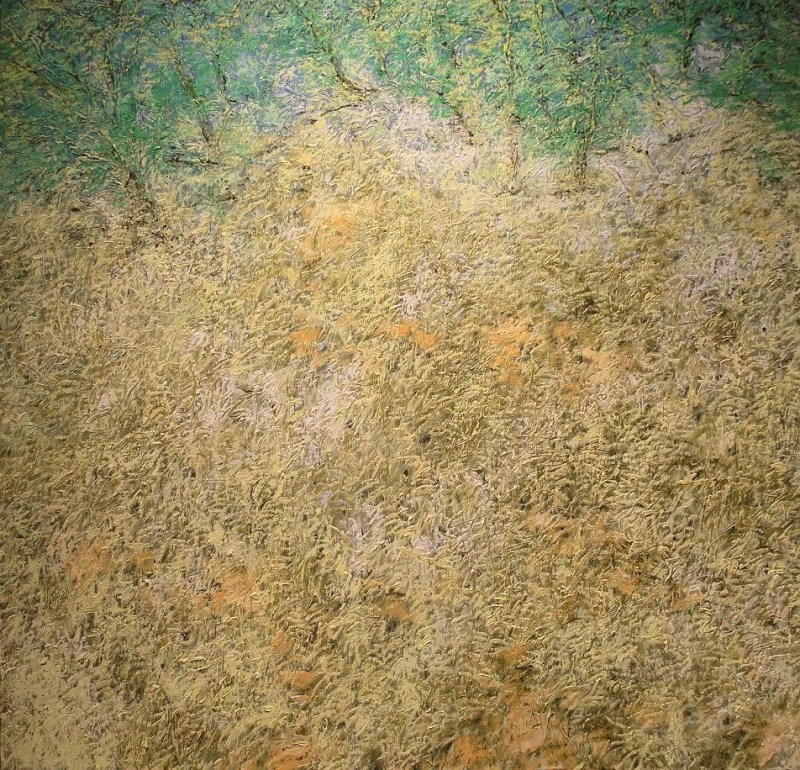
White Grass | 2004 | Oil on canvas | 48" x 48"
In the early sixties, I first encountered a painting by Paramjit in a not so well-lit Delhi Shilpi Chakra group show - a deserted park of grey green, a lonely garden bench silhouetted against it on a gloomy winter day. Later when I became his colleague in Jamia Milia University, I had the opportunity of observing his working process since we shared two adjoining rooms in the modest studio complex of the Department of Fine Arts. Preoccupation with landscape has been pivotal in Paramjit's works for the last four decades. During the formative years, he seems to have been inspired by the monumental still life shapes of Morandi and the architectural forms of de Chirico. During the seventies, series of flying stones became a recurring motif of his landscapes. This too disappeared as Paramjit became more and more involved with direct interaction with nature. He evolved greater simplification of forms which has given a specific identity to his work.
A miniature painting of an elephant playing Holi with Abir is a kind of visual metaphor for Paramjit's creativity. The abandon with which he carries out the act of painting is like playing Holi with colour points. Even though the entire process has been free, Paramjit never ventured out of his limited imageries of his so called landscapes. However, the historical conventions of landscapes do not apply to his work. Like a musician who prefers to sing only a few selected ragas, each time elaborating the unknown possibilities of the same notes, Paramjit occupies himself with a very few basic forms of nature. Sky, earth, water, trees, shrubs and grass are the ingredients of his repository. His landscapes have no specific identity of sites even though in his student days he would go to deserted monuments of Delhi to paint the picturesque scenes. The simplification achieved through a purely painterly process bears the stamp of his personality, superseding the limited representational character of particular sites. Human beings, animals, birds and insects are totally absent in his works. Their absence imparts his paintings with a mysterious quality. The form of trees and shrubs are a dark mass which gives weightage to the pictorial space. Sometimes they are vaguely suggested; sometimes they are just an abstract mass of colours. These heavy forms and the surrounding space are highlighted by a distant sky or a reflected water body and sometimes a lonely winding path leading nowhere.
It is natural that in the art arena of today's cerebral circus, Paramjit's paintings do not receive the attention they deserve because they are pure works of art. Rising above the thin dividing line between realism and abstraction, Paramjit transforms his picture-space into an animated painting-space with abundance of brush strokes which has become his signature. On close observation, these brush strokes are unbelievably rugged and broken without giving clue to how they function as suggestion of leaves, grass, the pathway or the water body. Nevertheless, they do integrate perfectly at a distance giving clear indication of artist's mastery over his method of handling the brush and pigments. Even though Paramjit's treatment of pigments is reminiscent of some of the Impressionist masters, he has very well absorbed it into his personal technique.
The sense of touch on the surface of the canvas is a vital factor in Paramjit's creative process. Just as the artist of the afore-said miniature painting has left his thumb impressions of vermillion red to cover the body of the elephant, Paramjit uses his brush as if it is the extension of his fingers. The frenzied movement of brush in different directions creates the rhythmic beat of the Bhangra dance together with the unconventional usage of colours suggest his roots.
Like the Indian political scenario, where the monolithic parties are disintegrating giving way to the regional parties, the Indian art scene is also opening up, shedding colonial hang ups and foreign patronage. As the vista of the Indian art scene expands to accommodate all valid experiments, I am sure that Paramjit will find his own permanent green patch
-A.Ramachandran
A.Ramachandran (b. 1935) is a painter based in Delhi. He has held several solo shows besides participation in significant group shows across India and abroad. He was conferred the Padma Bhushan award by the Government of India in 2005. Besides painting, he also has to his credit several children's books published in India, Japan, England and the USA which have received international acclaim.